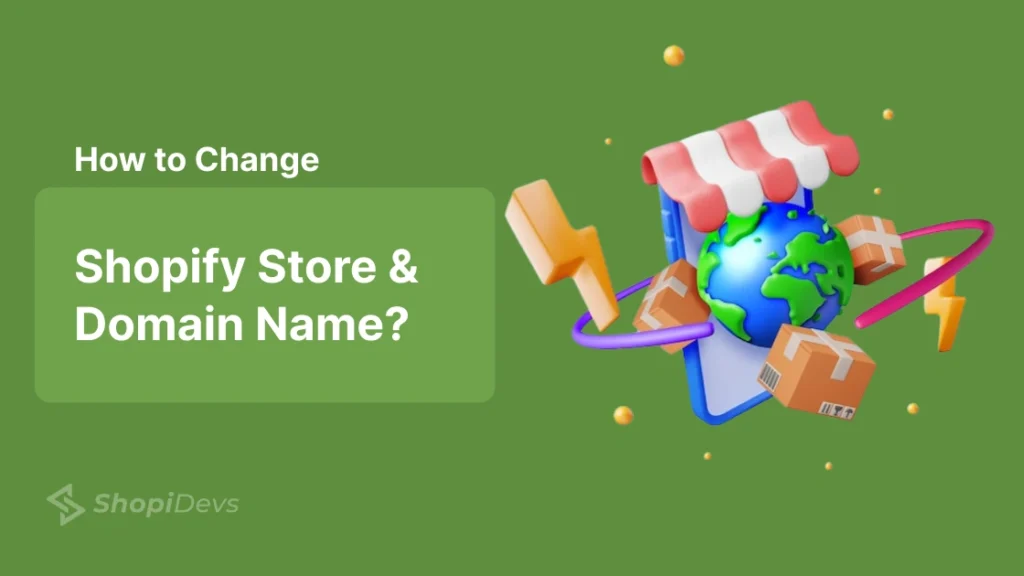Changing your Shopify store name is a strategic move that can impact your branding, visibility, and overall market positioning. Whether you’re rebranding, expanding, or simply fixing a confusing name, choosing the right store name can attract more customers and build trust.
In this guide, we’ll walk you through the exact steps to change name of Shopify store. We’ll also discuss when to make the change, tips for picking a strong name, and the key differences between your store name and domain. If you’re also considering a domain change, we’ve got you covered!
When Should You Change Your Shopify Store Name?
Your Shopify store name is more than just a label—it’s your brand’s identity. It’s the first thing people notice, and it can leave a lasting impression. But what if your current store name isn’t working anymore? Businesses evolve, trends shift, and sometimes, a fresh name can make all the difference.
If you’re wondering whether it’s time for a name change, here are some clear signs that it might be a smart move.
1. Your Store Name is Too Close to a Competitor’s
Imagine pouring your heart into your brand, only to find that people confuse it with another business. Worse yet, what if that business has a bad reputation? If your store name is too similar to a competitor’s, you could be losing customers without even realizing it.
On top of that, legal issues might arise if the name is trademarked. To avoid future headaches, it’s best to go for something unique that helps you stand out.
🔹 Example: If your store is called “Green Earth Essentials”, but there’s a larger brand named “Green Earth Naturals”, you risk losing customers to them. Choosing a distinct name, like “Purely Green Goods”, might be a better option.
2. The Name is Confusing or Hard to Remember
If people can’t spell, pronounce, or remember your store name, that’s a big problem. Word-of-mouth is one of the most powerful marketing tools, but if your name isn’t easy to recall, it won’t spread as quickly.
A name should be simple, catchy, and clear so customers can find you effortlessly online and offline.
🔹 Example: A name like “Xzlyx Fashion” might look unique, but it’s difficult to pronounce. Something like “Luxe Threads” would be much easier for people to remember and search for.
3. Your Business Has Outgrown the Name
What if your store name no longer reflects what you sell? Businesses evolve, and your brand should, too. If you started with one type of product but expanded your inventory, your name should reflect that growth.
🔹 Example: A store named “Just Coffee Mugs” made sense when you only sold mugs. But if you’ve expanded into teapots, tumblers, and drink accessories, a name like “The Coffee & Tea Haven” would be a better fit.
4. You’re Going Through a Rebrand
Rebranding isn’t just about changing a logo or colors—it’s about redefining your entire brand identity. If you’re targeting a new audience or shifting your business direction, a name change might be necessary to match your fresh image.
🔹 Example: If your store was called “Budget Tech Deals”, but now you’re focusing on high-end electronics, a name like “Elite Gadgets Hub” would better represent your new brand.
5. You’re Expanding Your Business
Sometimes, a name can limit your growth. If you started with a specific niche but now offer a wider range of products, a name change can help attract a broader customer base.
🔹 Example: A store called “Dog Collars Direct” makes it sound like you only sell collars. But if you now sell dog beds, toys, and food, a name like “Pawfect Pet Supplies” would make more sense.
6. Merging with Another Business
If you’ve acquired another Shopify store or merged with a brand, you might need a new name to reflect this union. Customers will appreciate a seamless transition rather than dealing with two different brand names.
🔹 Example: If “Fresh Harvest Organics” merges with “Nature’s Market”, a combined name like “Pure Harvest Market” could work well.
7. Your Domain Name Has Changed
Your store name and domain should match as closely as possible. If you’ve changed your domain for SEO or branding reasons, updating your Shopify store name ensures consistency.
🔹 Example: If you moved from “BestPhoneCases.com” to “TechAccessoriesHub.com”, it makes sense to rename your store to match the domain.
How to Choose a Memorable Name for Your Shopify Store
Your Shopify store’s name is the foundation of your brand identity. It influences customer perception, affects marketing success, and plays a critical role in brand recall. A well-crafted store name is unique, relevant, easy to remember, and available across digital platforms.
If you’re naming or rebranding your Shopify store, follow these key factors to make your name stand out, attract the right audience, and support long-term business growth.
1. Choose a Meaningful Name
A meaningful name communicates something important about your business, such as the products you sell, your values, or the emotions you want to evoke.
For example:
- A sustainable clothing brand could use “EcoWear Collective” to highlight its eco-friendly mission.
- A handmade jewelry store might choose “Timeless Trinkets” to emphasize unique, long-lasting pieces.
A name with significance helps customers connect with your brand instantly and understand your business at a glance.
2. Keep It Short and Simple
Short names are easier to remember, spell, and type, which boosts brand recall. Long or complicated names can confuse customers and make your store harder to find online.
✅ Better Example: “Wooden Wonders”
❌ Avoid: “The Best Custom Handcrafted Wooden Furniture and Décor”
Ideally, keep your store name between 1-3 words for maximum impact.
3. Make It Catchy and Memorable
Your store name should have a pleasant, catchy sound that makes it easy for customers to remember and share. Consider using:
✔ Alliteration: “Pretty Petals,” “Breezy Blooms”
✔ Rhyming Words: “FitBit,” “Snack Pack”
✔ Unique Combinations: “SnapCart,” “GlowHive”
A memorable name increases word-of-mouth marketing and helps customers recall your brand effortlessly.
4. Think About Future Expansion
Avoid choosing a name that’s too restrictive. Your business may expand, so pick a flexible name that allows growth.
✅ Better Example: “ZenActive” (allows expansion into fitness and wellness products)
❌ Avoid: “Yoga Mats Pro” (limits you to selling only yoga mats)
Always consider your long-term vision before finalizing a store name.
5. Check for Domain Name Availability
A great store name loses its power if you can’t secure a matching .com domain. Since most customers search for businesses online, having a domain that matches your brand is crucial.
How to check domain availability:
- Shopify Business Name Generator
- Namecheap
- GoDaddy
If your ideal domain isn’t available, consider small modifications:
✔ Add a keyword: GlowHiveShop.com
✔ Use hyphens (if necessary): Glow-Hive.com
A matching domain strengthens brand consistency and makes it easier for customers to find you.
6. Ensure Your Name is Relevant
Your store name should give customers a clear idea of what you sell.
For example:
- A minimalist jewelry brand could use “Sleek Stones” for a modern, elegant feel.
- A pet supply store might go with “Pawfect Pet Supplies” to attract pet owners.
Relevance eliminates confusion and immediately links your brand to your industry.
7. Use Name Generators for Inspiration
If you’re stuck, business name generators can spark creativity. These tools suggest unique name ideas based on relevant keywords.
Popular Name Generators:
- Shopify Business Name Generator
- Namelix
- BrandBucket
Even if you don’t use the exact suggestions, these tools can help inspire creative ideas that fit your brand vision.
8. Avoid Trademark Conflicts
Before finalizing your store name, check if it’s legally available. Using a trademarked name can lead to legal issues and costly rebranding.
Check trademarks through:
- United States Patent and Trademark Office (USPTO) (for U.S. businesses)
- Intellectual Property Office (IPO) (for UK businesses)
- Global Brand Database (for international businesses)
Avoiding trademark issues protects your business and prevents future legal headaches.
9. Secure Social Media Handles
A consistent brand name across Instagram, Facebook, Twitter, Pinterest, and TikTok ensures customers can find and engage with your store easily.
If your desired handle is taken, try small tweaks:
✔ Add a word: @GlowHiveShop instead of @GlowHive
✔ Use an underscore or abbreviation: @Glow_Hive
Consistency across platforms strengthens brand recognition.
10. Consider Your Target Audience
Your store name should resonate with your ideal customers. Think about their age, interests, and lifestyle.
For example:
- A luxury skincare brand could choose “Luminé Beauty” for a sophisticated feel.
- A trendy fashion store for Gen Z might go with “GlowVibes” to appeal to younger shoppers.
Understanding your audience helps ensure your brand name connects with the right people.
11. Compare With Competitors
Before finalizing your store name, research competitors in your niche to ensure your name is unique and stands out.
✅ Ask yourself:
✔ Does my name sound different from competitors?
✔ Is it easy to pronounce and remember?
✔ Does it align with my brand identity?
For example, if most eco-friendly brands use names like “EcoWear” or “GreenStyle,” you might choose “VerdeVibe” to differentiate your store.
Avoid names that blend in too much—you want your business to be distinct and memorable.
Shopify Store Name Vs. Shopify Store Domain

Your Shopify store name is the name you choose for your store when you set it up. This name will appear in various places, such as the checkout page and on your admin panel. It can be anything you want and is often related to your brand.
Your Shopify store domain, on the other hand, is the web address where customers can find your store online (like yourstorename.myshopify.com). This domain is initially provided by Shopify when you sign up, but you can also purchase a custom domain (e.g., www.yourbrand.com) for a more professional appearance.
In short:
- Store Name = The name of your shop.
- Store Domain = The URL of your shop.
You May Also Like to Read: Do I have to Customize My Shopify Store?
How to Change Shopify Store Name? Step By Step Guide
To change your Shopify store name:
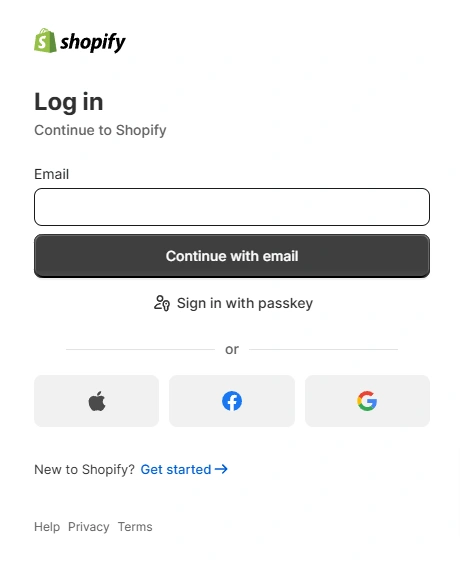
Step-1: Log in to your Shopify admin.
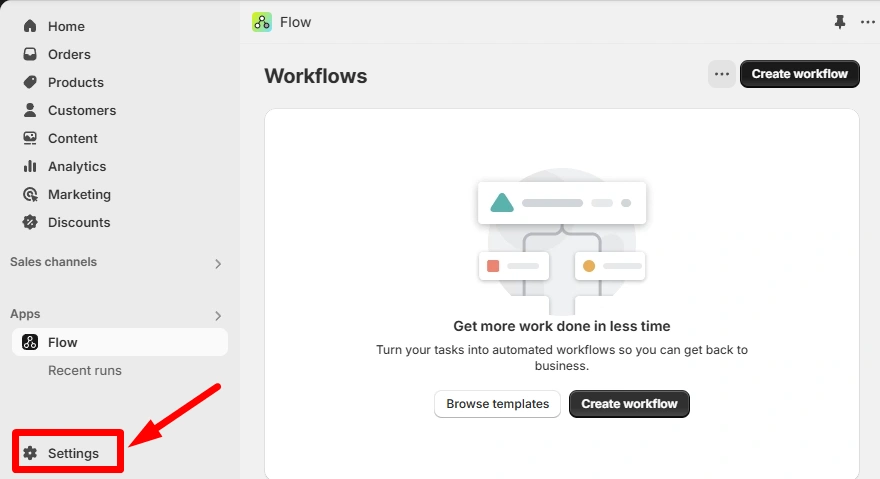
Step 2: Click Settings (bottom left corner).
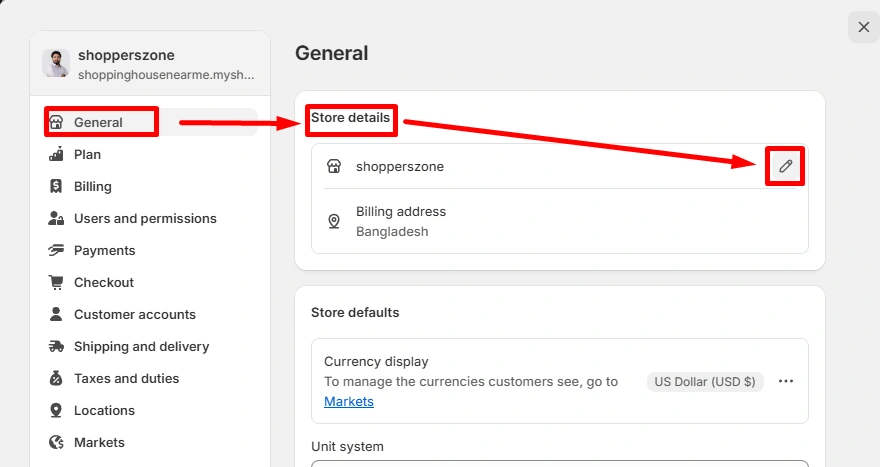
Step 3: Select General. Then, in the Store details section, click the pencil icon.
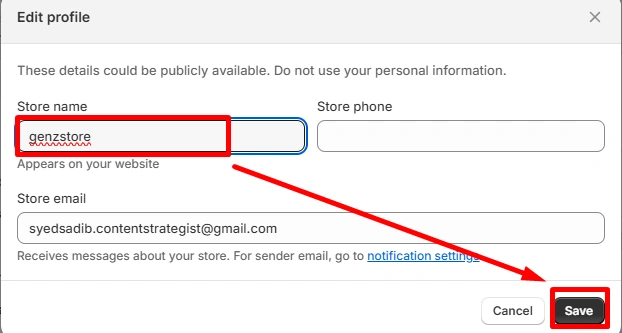
Step 4: Under Store name, enter the new name. Then, click Save.
You May Also Like to Read: Best Shopify Sections Apps to Customize Your Store
How to Change Shopify Domain Name?
To change your Shopify domain name, add a custom domain and set it as your primary domain.
Here’s how to update your domain:
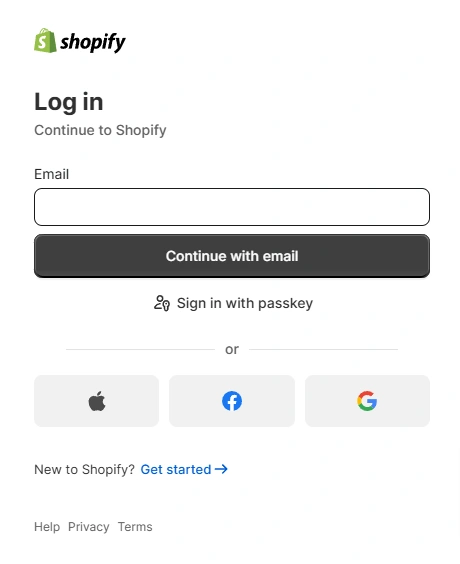
Step 1: Log in to your Shopify admin.
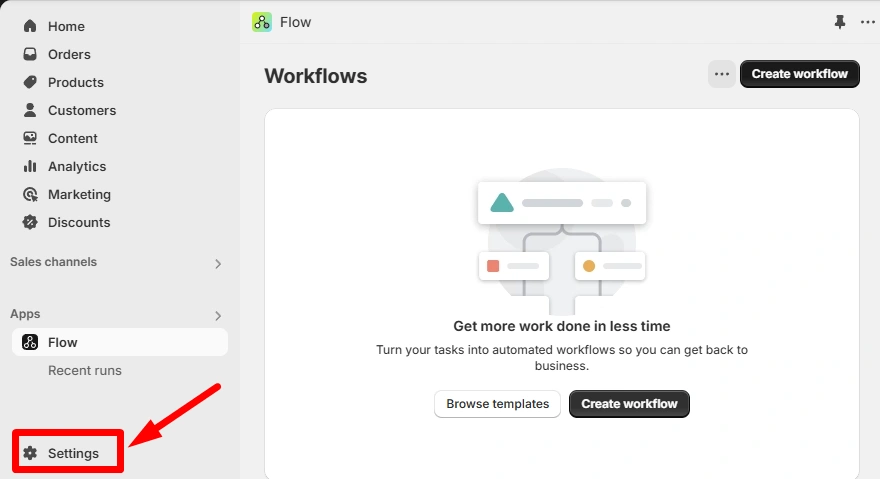
Step 2: Go to Settings

Step 3: Select Domains. Then, click Connect existing domain.
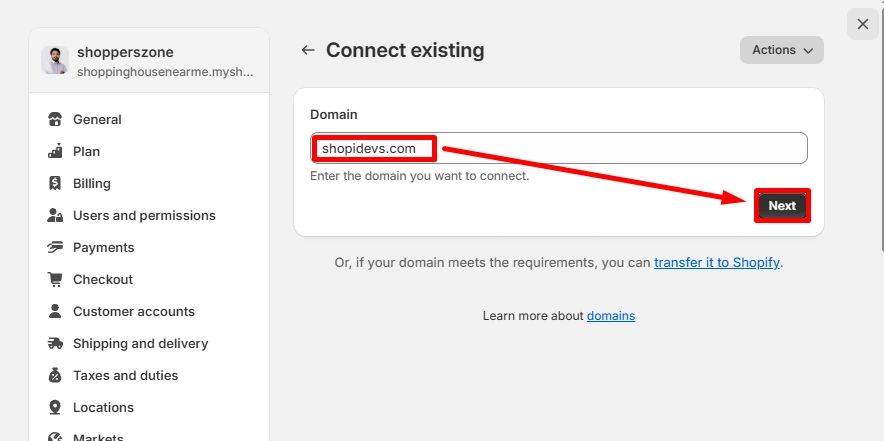
Step 4: Write your preferred domain. Then, click Next.

Step 5: Login to your domain provider and click on verify connection.

Note: You can also buy new domain from Shopify as well.
Read More: Can You Have Multiple Shopify Stores?
Final Thoughts
Changing your Shopify store name is a simple process but requires careful planning. Whether you’re rebranding, expanding, or correcting a naming issue, following this guide will help you make a smooth transition.
Make sure to update all branding materials, inform your customers, and align your new store name with a strong domain to maximize your success!
FAQs
Does the Name of Your Shopify Store Matter?
Yes, your Shopify store name matters as it impacts brand identity, trust, SEO, and marketing. A unique, memorable name helps attract customers, builds credibility, and improves search visibility. It should be relevant, easy to spell, and available as a domain and social handle for consistency across online platforms.
Does My Shopify Store Name Have to Match My Business Name?
No, your Shopify store name doesn’t have to match your business name, but consistency helps with branding. Using the same name builds trust and recognition. However, you can choose a different name for creative, marketing, or domain availability reasons, as long as it aligns with your brand identity.
Is There a Limit to Changing My Shopify Store Name?
You can change your Shopify store name anytime in your settings, but your myshopify.com domain (e.g., yourstore.myshopify.com) cannot be changed after creation. If you want a new public name, update your store name and purchase a custom domain to reflect the new branding without affecting your backend URL.
Does a Shopify Store Name Change Affect Seo?
Yes, changing your Shopify store name can affect SEO, especially if your previous name had rankings or backlinks. Updating your store name without redirecting URLs or maintaining keyword consistency may impact search visibility. To minimize effects, update meta tags, redirects, and branding across platforms for a smooth SEO transition.
Can I Match My Shopify Store Name to My New Domain?
Yes, you can match your Shopify store name to your new domain. It’s a good idea to use the same name for consistency and brand recognition. If the domain name is available, you can purchase it and set it up for your Shopify store.
How Do I Redirect Old URLs after Changing My Shopify Store Name or Domain?
To ensure your customers and search engines can still find your store after changing your Shopify store name or domain, you’ll need to set up 301 redirects. This tells search engines that the content has permanently moved to a new URL. Here’s how you can do it:
➤ Log into Shopify Admin.
➤ Go to Online Store > Navigation.
➤ Scroll to URL Redirects and click Create URL Redirect.
➤ Enter the Old URL and New URL.
➤ Click Save Redirect.
For Bulk Redirects:
➤ Click Import under URL Redirects.
➤ Download the CSV template, and fill in old and new URLs.
➤ Upload the file to apply the redirects.
This ensures your old URLs point to the correct new ones.
Do Apps and Integrations Work After a Shopify Store Name Change?
Yes, apps and integrations generally work after a Shopify store name change, as long as the domain stays the same. If you change the domain, some apps may need to be reconfigured or reauthenticated. Check app settings and update URLs if needed. For custom integrations, ensure they’re updated to reflect the new domain.
You May Also Like to Read: How to Make Shopify Store Live
I am an SEO-friendly content and copywriter with 7 years of experience. I am confident in making and managing valuable digital content. My experience also includes executing successful SEO projects, managing teams, and staying up-to-date with the latest digital marketing trends and SEO updates.
